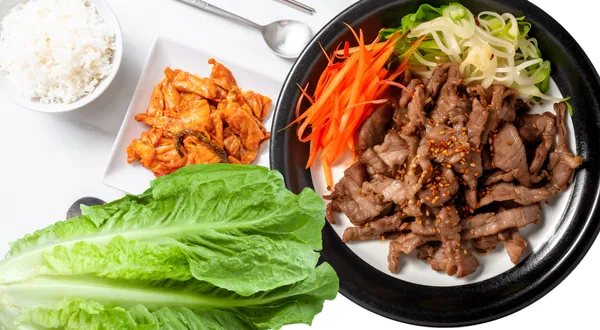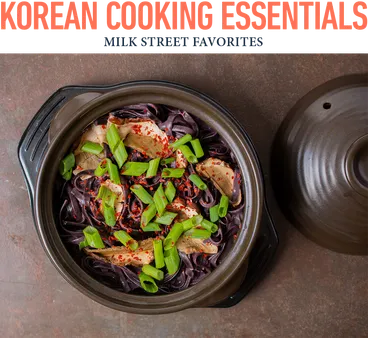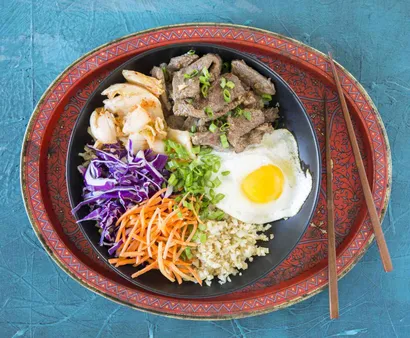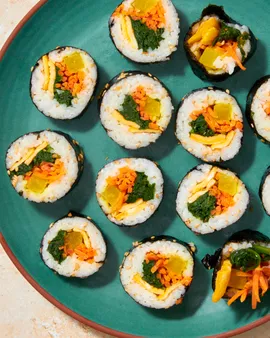Table of Contents
Welcome to Tauhuichiban's definitive guide to The ingredients and tools you need for Korean cooking. Mastering Korean cuisine requires the right ingredients and tools, and we've got you covered. In this comprehensive resource, we'll delve into the essential ingredients that form the foundation of Korean flavors, from gochujang to gochugaru. We'll also explore the indispensable tools that make Korean cooking a breeze, from woks to rice cookers. With our recommendations, you'll be well-equipped to create authentic and delicious Korean dishes in your own kitchen.

The Ingredients and Tools You Need for Korean Cooking
I. The Essential Ingredients for Korean Cooking
Korean cuisine is known for its bold flavors and diverse ingredients. To achieve the authentic taste of Korean dishes, it is essential to have the right ingredients on hand. Here are some of the most important ingredients used in Korean cooking:
- Gochujang (Korean chili paste): This spicy, fermented paste is a staple ingredient in many Korean dishes, adding a rich, savory flavor.
- Doenjang (soybean paste): This fermented soybean paste is used to make soups, stews, and marinades, adding a salty, umami flavor.
- Ganjang (soy sauce): This fermented soybean sauce is used as a seasoning and dipping sauce, adding a salty, savory flavor.
- Sesame oil: This nutty-flavored oil is used to add flavor to dishes, and is often used in stir-fries and marinades.
- Garlic: Garlic is a common ingredient in Korean cooking, adding a pungent, savory flavor to dishes.
- Ginger: Ginger is another common ingredient in Korean cooking, adding a warm, spicy flavor to dishes.
- Green onions: Green onions are often used as a garnish in Korean dishes, adding a fresh, oniony flavor.
- Kimchi: This fermented cabbage dish is a staple side dish in Korean cuisine, adding a spicy, sour flavor to meals.
In addition to these essential ingredients, there are many other ingredients that are commonly used in Korean cooking, such as rice, noodles, vegetables, and meat. By having the right ingredients on hand, you can create delicious and authentic Korean dishes at home.
Ingredient | Description |
|---|---|
Gochujang (Korean chili paste) | A spicy, fermented paste made from red chili peppers, soybeans, and glutinous rice |
Doenjang (soybean paste) | A fermented soybean paste made from soybeans, salt, and water |
Ganjang (soy sauce) | A fermented soybean sauce made from soybeans, wheat, and salt |
Sesame oil | A nutty-flavored oil made from sesame seeds |
Garlic | A pungent, savory bulbous plant |
Ginger | A warm, spicy rhizome |
Green onions | A type of onion with a long, green stalk and a white bulb |
Kimchi | A fermented cabbage dish made from cabbage, radishes, and other vegetables |
Here are some tips for using these essential ingredients in your Korean cooking:
- Use gochujang sparingly, as it can be quite spicy.
- Doenjang can be used as a substitute for soy sauce in many dishes.
- Ganjang is a good all-purpose seasoning that can be used in a variety of dishes.
- Sesame oil should be used in moderation, as it can be overpowering.
- Garlic and ginger should be minced or grated before using.
- Green onions can be used as a garnish or added to dishes for flavor.
- Kimchi can be eaten as a side dish or added to dishes for flavor.
With these essential ingredients and tips, you can create delicious and authentic Korean dishes at home.
Here are some additional tips for using these essential ingredients in your Korean cooking:
- Gochujang can be used to make a variety of sauces, such as ssamjang (a dipping sauce for grilled meats) and tteokbokki sauce (a spicy sauce for rice cakes).
- Doenjang can be used to make soups, such as doenjang jjigae (a soybean paste stew) and dubu jjigae (a tofu stew).
- Ganjang can be used to make marinades, such as galbi marinade (a marinade for grilled short ribs) and bulgogi marinade (a marinade for grilled beef).
- Sesame oil can be used to make stir-fries, such as japchae (a stir-fried glass noodle dish) and bibimbap (a mixed rice dish).
- Garlic and ginger can be used to make a variety of side dishes, such as kimchi (a fermented cabbage dish) and oi muchim (a cucumber salad).
- Green onions can be used to garnish a variety of dishes, such as soups, stews, and rice dishes.
- Kimchi can be used to add flavor to a variety of dishes, such as soups, stews, and rice dishes.
By following these tips, you can create delicious and authentic Korean dishes at home.

The Essential Ingredients for Korean Cooking
II. The Indispensable Tools for Korean Cooking
Preparing Korean cuisine necessitates a specialized set of tools that facilitate the creation of authentic dishes with precision and ease. These essential utensils play a pivotal role in shaping the flavors, textures, and presentation of Korean food, enhancing the overall culinary experience.
Let's explore some of the most indispensable tools for Korean cooking and their pivotal roles:
Tool | Purpose |
|---|---|
Perfectly prepares fluffy and evenly cooked rice, the foundation of many Korean dishes. | |
A heavy-bottomed pot specifically designed for making stews and soups, ensuring even heat distribution and prevents scorching. | |
A traditional Korean mortar and pestle used for grinding and crushing ingredients, creating flavorful pastes and sauces. | |
Effortlessly creates thin, uniform slices of vegetables for salads, kimchi, and other preparations, ensuring consistent texture and presentation. |
These are just a few examples of the essential tools that equip Korean cooks with the means to create authentic and delectable dishes. With these tools in hand, you can confidently embark on your culinary journey into the vibrant world of Korean cuisine.
III. Recipes to Showcase Your Korean Cuisine Mastery
Enhance your culinary skills with our curated selection of Korean recipes, designed to impress your taste buds and elevate your cooking abilities. Whether you're a seasoned chef or a home cook seeking to explore the vibrant flavors of Korean cuisine, our comprehensive guide will guide you every step of the way.
Indulge in the tantalizing flavors of kimchi pancakes, a crispy and savory treat that captures the essence of traditional Korean flavors. Experiment with the spicy and addictive gochujang sauce, a versatile condiment that adds depth and heat to any dish. For a comforting and hearty meal, try our dolsot bibimbap, a sizzling stone bowl filled with rice, vegetables, and your choice of protein.
Table: Essential Korean Ingredients
Ingredient | Description |
|---|---|
Gochujang | Spicy fermented red pepper paste |
Doenjang | Fermented soybean paste |
Gochugaru | Korean chili flakes |
Kimchi | Fermented cabbage |
Soy sauce | Liquid condiment made from fermented soybeans |
Expand your culinary repertoire with our curated collection of Korean cooking techniques. Learn the art of making kimchi, a fermented cabbage dish that forms the foundation of many Korean meals. Master the delicate balance of flavors in japchae, a glass noodle dish tossed in a sweet and savory sauce. For a delightful sweet treat, try your hand at making songpyeon, traditional Korean rice cakes filled with sweet red bean paste.
Whether you're seeking a quick and easy weeknight meal or an elaborate feast to impress guests, our collection of Korean recipes offers something for every occasion. Surprise your loved ones with a traditional Korean breakfast of steamed buns, filled with savory or sweet fillings. Explore the vibrant flavors of Korean street food with our tteokbokki recipe, featuring chewy rice cakes tossed in a spicy gochujang sauce.
List: Must-Have Korean Tools
- Cast-iron pot
- Stone bowl
- Kimchi crock
- Wooden rolling pin
- Cutting board
Embark on a culinary adventure with our comprehensive guide to Korean cuisine. Discover the secrets of authentic Korean dishes, expand your cooking skills, and elevate your home cooking to new heights. Whether you're a culinary novice or a seasoned chef, our collection of recipes and techniques will inspire you to create delicious and authentic Korean meals.

Recipes to Showcase Your Korean Cuisine Mastery
IV. Tips and Techniques for Authentic Korean Cooking
Mastering the art of Korean cuisine requires not only the right ingredients but also an understanding of essential techniques. Here are some tips to elevate your Korean cooking skills:
- Use high-quality ingredients: Fresh, authentic ingredients are crucial for achieving the true flavors of Korean dishes.
- Marinate your meats: Marinating meats in a flavorful sauce before cooking tenderizes them and infuses them with flavor.
- Control the heat: Korean cooking often involves high heat, but it's essential to control the temperature to prevent burning.
- Use a variety of cooking methods: Korean cuisine employs various cooking methods, including grilling, stir-frying, steaming, and braising, to create diverse textures and flavors.
- Balance flavors: Korean dishes often combine sweet, salty, sour, and spicy flavors to create a harmonious balance.
By following these tips and techniques, you can recreate the authentic flavors of Korean cuisine in your own kitchen.
Here are some additional tips for mastering Korean cooking:
- Use a sharp knife: A sharp knife is essential for precise cutting and slicing, which is crucial in Korean cuisine.
- Invest in a good set of cookware: A good set of cookware, including a wok, a cast-iron skillet, and a steamer, will help you achieve the best results.
- Don't be afraid to experiment: Once you have mastered the basics, feel free to experiment with different ingredients and flavors to create your own unique Korean dishes.
With practice and patience, you can become a skilled Korean cook and impress your friends and family with your culinary creations.

Tips and Techniques for Authentic Korean Cooking
V. Conclusion
With the right ingredients and tools at your disposal, you are well on your way to mastering the art of Korean cooking. Remember to experiment with different ingredients and techniques to find what you enjoy most. Korean cuisine is a vast and diverse culinary landscape, so don't be afraid to explore and discover new flavors. With patience and practice, you'll be able to create authentic and delicious Korean dishes that will impress your family and friends. So gather your ingredients, sharpen your tools, and embark on this exciting culinary adventure. The world of Korean cooking awaits your exploration!